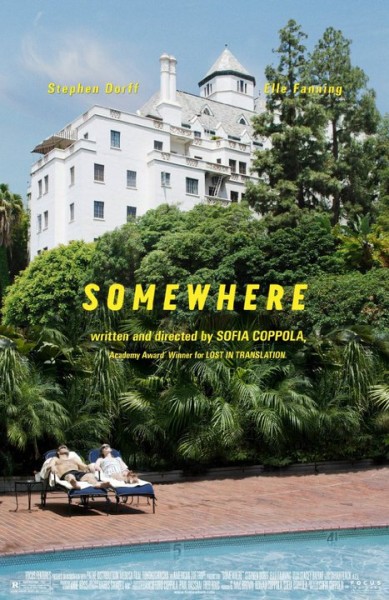The movie Somewhere, written and directed by Sofia Coppola, perfectly embodies my like-hate relationship with the director’s body of work. The premise is there and the actors are in place, but like many of Coppola’s other films, it ultimately falls flat on its face (Or maybe it was dead on arrival. Jury’s still out.)
Stephen Dorff plays Johnny Marco, a celebrity actor and playboy who lives in a hotel, bangs tons of chicks, and parties til the sun comes up. He has a daughter, 11-year-old Cleo (Elle Fanning) who moves in with him after her mother suddenly announces a departure with an unknown return date. They travel to Italy for a press tour, they play guitar hero, they co-exist. But they barely talk the entire time. They eat some food. They lay by the pool.
This “plot” description is basically what viewers can look forward to. Sure, Marco’s life is changed from his former party days, but rarely do we actually witness a real connection between the two. Rarely do we see Marco’s transformation into his new Daddy-of-the-Year role aside from a few long stares into nothingness. I’m all for subtlety, but when must the line be drawn between subtlety and nothingness? Upon film’s end, viewers are left without any real understanding of the relationship between the characters and also of the characters themselves.
I’ve had similar struggles with other Coppola films. GASP! But, before you get all crazy-eyes on me, I did like Lost in Translation, but the same devices are often over-utilized from film to film. The main character “grows” and “learns,” but much of this is done inside his or her head because they’re too busy brooding, staring, existing. That said, Lost in Translation was also bolstered by outstanding performances from Bill Murray and ScarJo–performances so strong, in fact, that other movies like Somewhere and Marie Antoinette just seem lacking. Lost in Translation, Murray, and ScarJo simply pulled it off this time.
Yes, I can draw that Marco’s character is supposed to learn a great deal, be a different man, etc., but oftentimes the source material just doesn’t support the points that Coppola is trying to deliver. It’s as if Somewhere really only gets halfway there.
With a little added progression, it may have been an OK turnout. Rather, I’m still left feeling unsatisfied, frustrated and bored with Coppola’s storytelling. It’s the same feeling and experience I had after watching Kirsten Dunst prance around in outlandish eighteenth-century get-ups to the tunes of Bow Wow Wow and The Cure. Some of the elements are uniquely tuned, but they’re not enough to make it a slam dunk.




This is a really well-written review, Nick! I understand what you’re getting at with “films like this” but, that said, I really liked “Marie Antoinette” and “The Virgin Suicides” (A film whose name I could barely even utter aloud before a friend forced me to finally watch it) as well as “Lost in Translation,” so, I am going to give this one a go on the Netflix Queue and see what happens. Expect a future report.